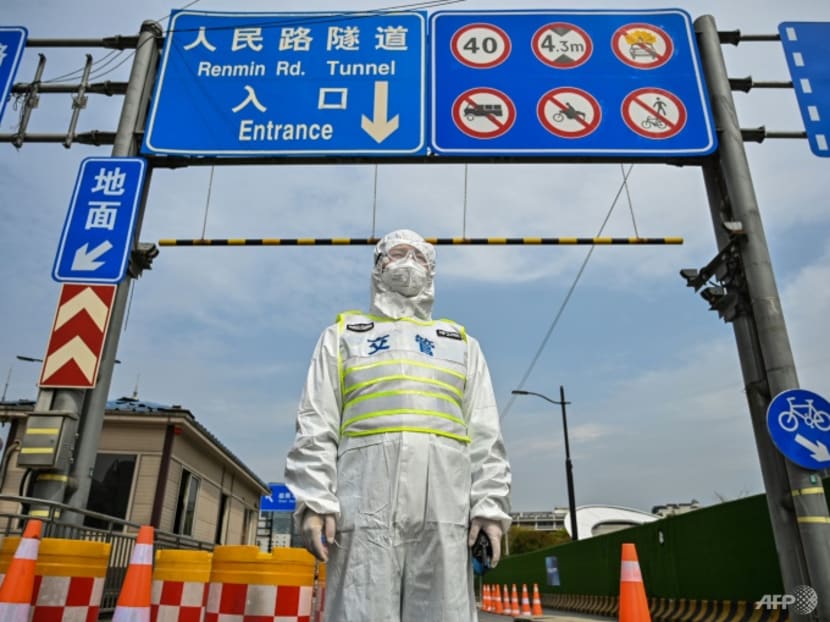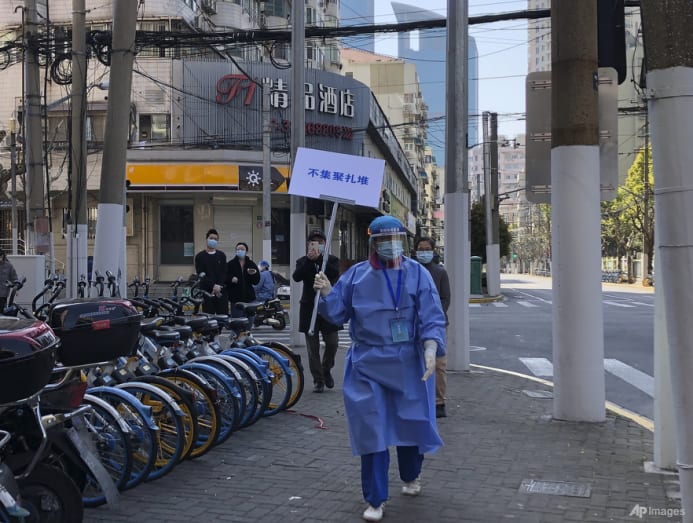Commentary: Why China is doubling down on zero-COVID while Omicron spreads in Shanghai
It will be unrealistic to expect China to shift to “living with the virus” in a year when the Omicron variant is still raging and Beijing is due to hold the 20th National Party Congress, says NUS East Asian Institute's Chen Gang.

SINGAPORE: Shanghai, once a model city for its flexible yet efficient COVID-19 control in China, is now in lockdown due to transmissible Omicron variant spreading among its 26 million residents.
The financial hub has been split in half, with each made to stay home and undergo mass testing at different stages, in what is China’s worst outbreak since the start of the pandemic.
It looks like China is doubling down on its zero-COVID stance, despite grievances and fatigue among the people with seemingly endless cycles of testing, quarantine and travel restrictions. China stands in sharp contrast to countries worldwide that are relaxing restrictions to live with an endemic COVID-19.
Last year, China started adopting the “dynamic zero-COVID” policy to replace its absolute zero-tolerance stance. Shanghai’s approach is described as “slicing and gridding”, where neighbourhoods are shut down and tested one by one.
In contrast to city-wide lockdowns, the more flexible prevention measures try to strike a balance between disease control and enabling people to live normal lives. The reality was simply that many provinces could not keep the number of cases at zero as they had done from 2020 to 2021.
Moreover, the world’s second-largest economy is facing strong headwinds amid geopolitical tensions and global supply chain woes, and the government has had to prioritise the stabilisation of economic growth.
Once hailed by the Chinese public health community for its “scientific” and efficient way of curbing the pandemic, the Shanghai model allowed for both COVID-19 control and the continuation of economic activity through early detection, frequent contact-tracing and targeted community lockdowns.
In September 2021, the National Health Commission even held a special conference in Shanghai to call on other provinces to learn from its cost-effective experience.
SHANGHAI NO LONGER A MODEL CITY
Zhang Wenhong, a prominent epidemiologist from Shanghai, became the face of China’s COVID-19 battle due to his clever analogies and frank messages to the public. As one of China’s best-known medical experts during the pandemic, Zhang often advocated for practical and flexible approaches to tackling the virus.
Yet his celebrity status came under scrutiny when, in July 2021, he called for long-term coexistence with the virus, deviating from authorities’ hardline zero-COVID approach. He came under fire for his views, with netizens even accusing Zhang of plagiarising a part of his PhD dissertation more than two decades ago.
He kept a low profile for a while but appeared in press conferences as head of Shanghai’s COVID-19 expert team - until very recently. His absence after Shanghai announced the latest stringent lockdown measures indicates that his cost-effective approach has been abandoned by policymakers, replaced with the guideline of “fighting the virus regardless of costs”.
It’s obvious that Shanghai has lost its status as a model for COVID-19 control. Even with dynamic zero-COVID, the central leadership has shown it will not hesitate to lock down the entire cities when local cases are rising quickly.

After all, Shanghai authorities began shutting down the western half of the city two days ahead of schedule on Mar 30, while extending lockdown in some eastern districts on Apr 1.
It will be unrealistic to expect China to shift to “living with the virus” in a year when the Omicron variant is still raging and Beijing is going to hold the 20th National Party Congress.
ECONOMIC AND SOCIAL COSTS OF ZERO-COVID
Although it has become politically incorrect to question the government’s zero-COVID policy in China, the economic and social cost of locking down the entire Shanghai and other provinces could be extremely unbearable.
Lockdown anger is growing and public unhappiness at lockdown measures may reach boiling point. On social media, people expressed frustration over access to medical care and complained about difficulties purchasing food as delivery services were overloaded.
Some reported poor conditions in quarantine centres and questioned why those who test positive must go even when they are asymptomatic. Others have voiced anger at the policy of separating COVID-positive babies and young children from their parents.
Tech giant Tencent took down two videos of a rare protest at a Shanghai housing compound trending on its WeChat microblogging and video publishing platform. The ramped-up censorship reflects China’s determination to uplift dynamic zero-COVID to a political height that disallows public dispute.
Lockdowns prolong supply-chain bottlenecks, intensify inflationary pressures and weaken domestic consumption. According to China’s Everbright Securities, the country could see as much as 10 percentage points shaved off economic growth on a quarterly basis if zero-COVID is maintained.
What are the challenges in shifting to living with an endemic COVID-19? Listen to CNA's Heart of the Matter:
Eurasia Group listed the continuation of China’s zero-COVID policy as a top global economic risk in 2022. “Shipping constraints, COVID-19 outbreaks, and shortages of staff, raw material, and equipment – all more acute because of China’s zero-COVID policy – will make goods less available”, it wrote in January.
Chinese authorities are well aware of the risks if people’s demands are not addressed. Mass protests, like in Belgium, the Netherlands or the United States, are highly unlikely in Shanghai or other provinces. Many Chinese citizens still back zero-COVID and see low case numbers as a source of national pride.
If the lockdown drags on, huge inconveniences and difficulties imposed upon people’s lives and livelihoods may backfire and lead to widespread discontent. Hence, China’s logic is to contain the pandemic as quickly as possible, no matter how high the short-term cost could be.
ZERO-COVID, MISSION IMPOSSIBLE?
It may be unrealistic to eliminate COVID-19 entirely despite lockdowns and repeated testing, given Omicron’s high transmissibility and the large number of asymptomatic cases.
Hong Kong has been pursuing the same dynamic zero-COVID policy as mainland China, but since the beginning of 2022, the Omicron surge has called the city’s policy implementation into question.
The Asian financial hub still logged tens of thousands of new cases daily at the peak of the wave, though it has subsided to several thousand per day. But the goal of zero-COVID remains out of sight.
Elsewhere in China, Jilin province was put under lockdown after Mar 14, but the northeast province still reported 1,150 new cases and 1,032 asymptomatic cases on Mar 29.
It's too early to tell whether China can effectively curb this wave of infections as it did in Wuhan in 2020.
However, when handling the pandemic, local officials are extremely stressed by the enormous political stakes in the run-up to the 20th National Party Congress, the Chinese Communist Party’s once-in-five-years power reshuffling.
Promising cadres don’t want their political careers derailed by the failures of pandemic control. They are going all out to pursue zero-COVID regardless of the socioeconomic cost or their own mental health.
However, as Jilin, Shanghai and other places have been battling the latest wave of infections for about a month, frustration and fatigue are also on the rise among bureaucrats and medical workers. Understanding this, the Party’s anti-corruption watchdog and its organisation department have been mobilised to evaluate the performance of cadres in the pandemic fight.
Looking around the world, more and more countries have given up zero-COVID policy in the face of the Omicron variant and its BA.2 sub-variant.
Although “living with COVID-19” is still a political taboo in China, the authorities need to adapt to this new normal with more flexible and humanised measures for the sake of people’s mental and physical health.
Dr Chen Gang is a senior research fellow and assistant director of the East Asian Institute at the National University of Singapore.








